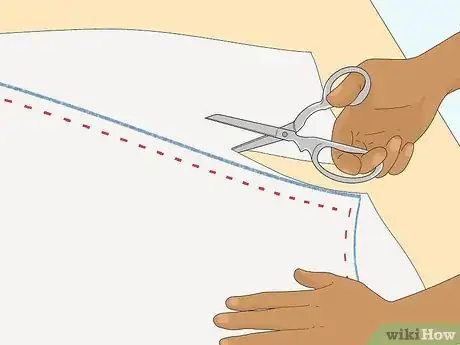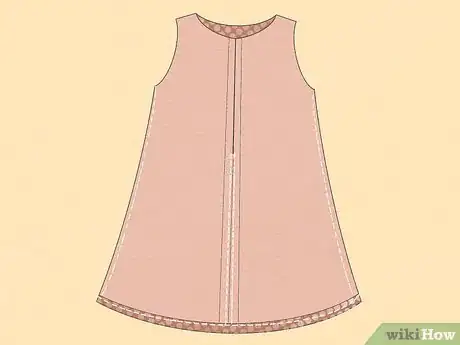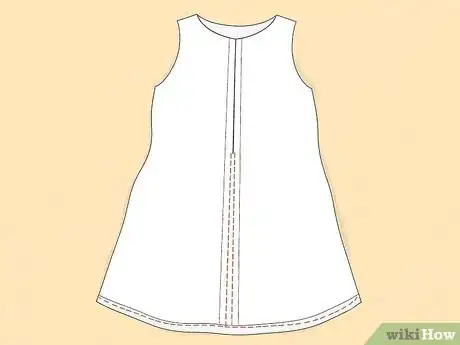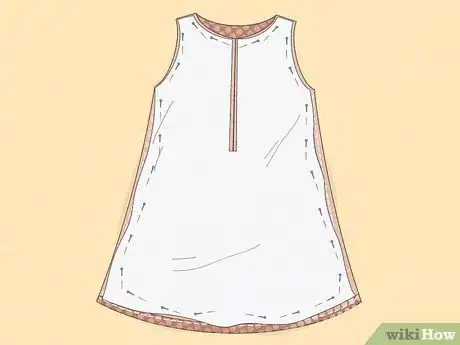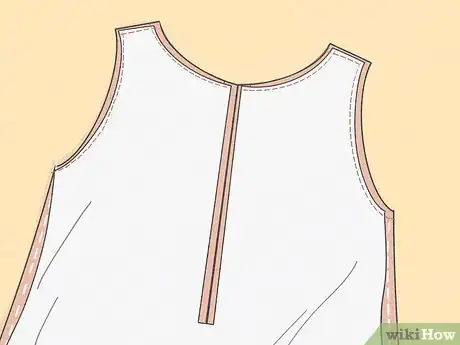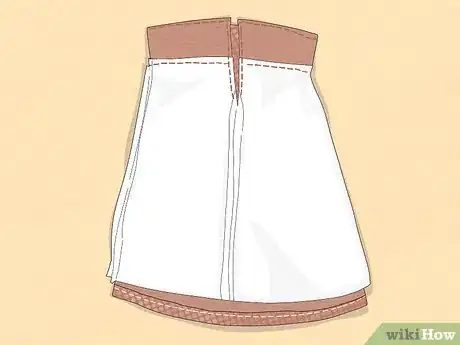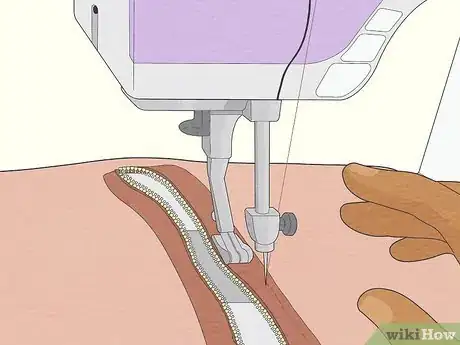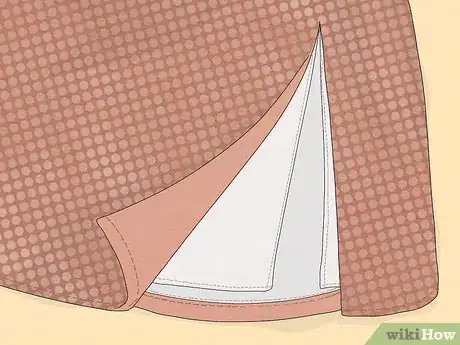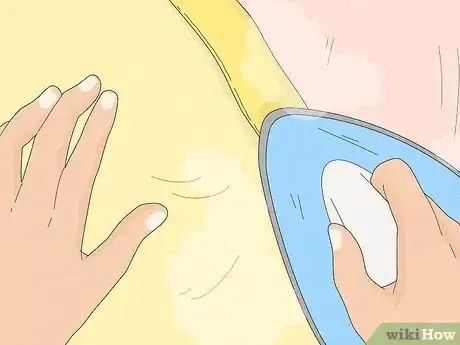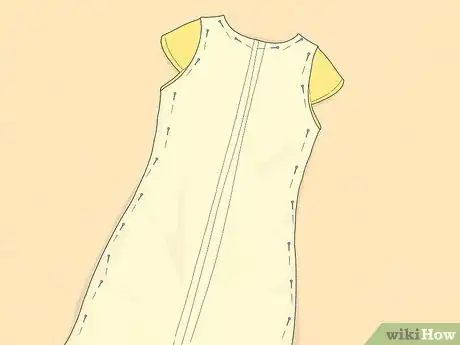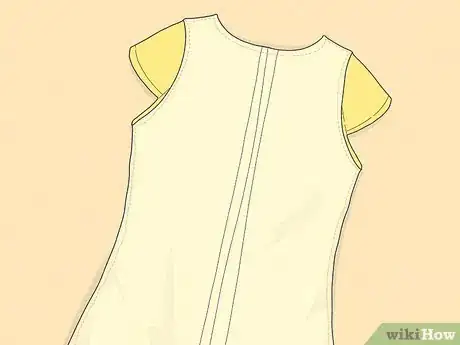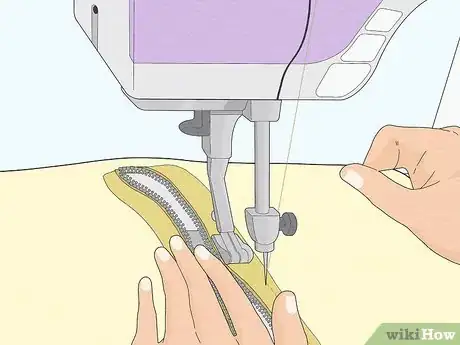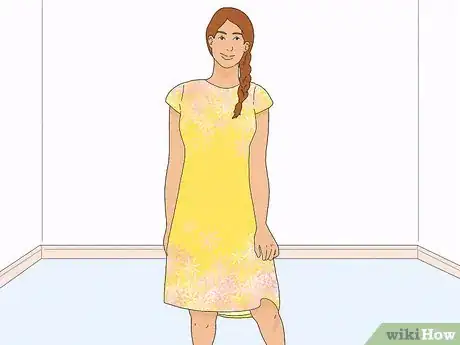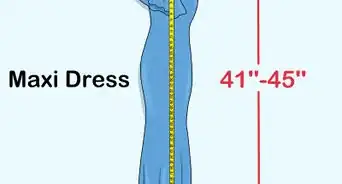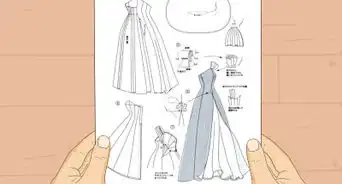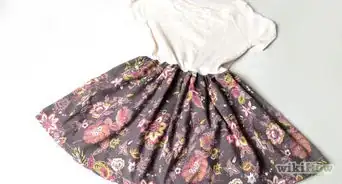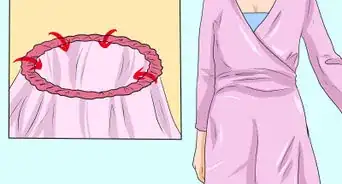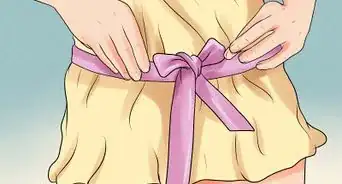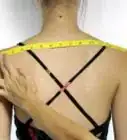This article was co-authored by Kpoene Kofi-Bruce and by wikiHow staff writer, Hannah Madden. Kpoene Kofi-Bruce is a tailor, couture wedding gown designer, and the Creative Director of Mignonette Bridal and Ette the Wedding Tailor in Chicago, Illinois. With nearly two decades of experience as a wedding gown designer, small business owner, and vintage sewing enthusiast, Kpoene specializes in wedding gown design and the social history of wedding dresses. She received a BA in Creative Writing from Middlebury College and studied the business of fashion at the Fashion Institute of Technology. She is also a graduate of the Goldman Sachs 10KSB program and the Chicago Fashion Incubator and has written about wedding fashion for Jezebel, Catalyst, the Sun Times, and XO Jane.
There are 10 references cited in this article, which can be found at the bottom of the page.
This article has been viewed 135,429 times.
Sewing lining into a dress can protect your skin from uncomfortable material and make the finished dress less see-through. The extra structure may also improve the overall fit and give the garment a more sophisticated appearance. You can add lining to both unfinished and finished dresses, but adding it before finishing the dress will usually result in cleaner edges.
Steps
Buying and Cutting the Lining
-
1Purchase a smooth-surfaced cotton blend for your lining. Popular lining options include smooth-surfaced cotton blends such as Viole, Habutai, crepe, thin satins, and Georgette. As a general rule, lining fabrics should be smooth, lightweight, and very flexible. If the dress fabric is sheer, match the lining color to your skin tone or the dress. If the fabric is opaque, you don’t have to worry about the lining color.[1]
- Do not use Negative Weight fabrics, heavy fabrics, taffeta, crinoline, or tulle as a lining. Negative weight fabrics will alter the form, and heavy fabrics will restrict movement and add bulk and weight.
Tip: If the original dress fabric has any stretch, the lining material must have an equal amount to prevent the fit from becoming warped.
-
2Buy the same amount of lining it took to make the dress. You don’t need to include any pieces that don’t touch your body, like the facings, collars, cuffs, or waistbands. If you have the dress pattern, you can work directly from that. Otherwise, measure the bodice, skirt, and sleeves, and add the totals together to get enough lining fabric. Buy a little bit extra just in case you need more as you cut the pattern.[2]
- You can find lining fabric at most fabric supply stores.
- If you're lining a dress to add structure, you might end up cutting your lining with a different shape from the top layer, as you might need to include interfacing or boning.[3]
Advertisement -
3Remove 1⁄8 in (0.32 cm) from the dress pattern for the lining. Trace the lining from the original pattern used to construct the main dress, but adjust the edges by taking away 1⁄8 inch (0.32 cm). This will ensure that the lining doesn’t hang below the hem of the dress in any areas.[4]
- Transfer any pattern markings, but don’t include any extra material for kick pleats.
- When working without a pattern, trace the lining from the actual bodice, skirt, and sleeves. Add a 1⁄8 in (0.32 cm) seam allowance to the neckline, shoulders, zipper opening, and armholes (sleeveless dress only).
-
4Cut out the lining pieces with sharp scissors. After tracing the lining pieces onto the material, use sewing shears or scissors to carefully cut out each one. Check the lining against the original dress to make sure the hems match up without hanging beneath the hem.[5]
Lining an Unfinished Dress
-
1Complete most of the main dress except for the neck and shoulders. Before lining the dress, you should follow the original pattern instructions to complete everything except for the outer edges. Leave the edges at the neck and shoulders raw, but finish the bottom hem. For sleeveless dresses, leave the armholes raw, too.[6]
-
2Assemble the lining by sewing it together like the dress. Follow the pattern instructions to stitch together the pieces of the lining as though making a separate dress. If you made your unfinished dress on your own, you’ll follow the same steps that you did earlier.[7]
- Every pattern is a little bit different, but this will most likely include sewing the torso and skirt together and then combining them with the sleeves, if your dress has any.
- Any edge left unfinished on the original dress (neck, shoulders, and armhole) should remain raw on the lining, as well.
- Leave the zipper opening unfinished, too. If the dress has any kick pleat or slit, you should also leave those edges unfinished.
Expert AnswerQHow many layers of lining do you need?
Kpoene Kofi-Bruce is a tailor, couture wedding gown designer, and the Creative Director of Mignonette Bridal and Ette the Wedding Tailor in Chicago, Illinois. With nearly two decades of experience as a wedding gown designer, small business owner, and vintage sewing enthusiast, Kpoene specializes in wedding gown design and the social history of wedding dresses. She received a BA in Creative Writing from Middlebury College and studied the business of fashion at the Fashion Institute of Technology. She is also a graduate of the Goldman Sachs 10KSB program and the Chicago Fashion Incubator and has written about wedding fashion for Jezebel, Catalyst, the Sun Times, and XO Jane.Couture Bridal Designer
 EXPERT ADVICEAnswer from Kpoene Kofi-Bruce:
EXPERT ADVICEAnswer from Kpoene Kofi-Bruce:I usually cut 2 or 3 layers—an underlining, which I use as a backing for the top layer of fabric, and then one or two layers of lining.
-
3Pin the lining pieces to the dress. Turn your dress inside out and pull the lining on top of it. Use sewing pins to attach the lining to the edges of the dress so that it stays in place.[8]
- The zipper opening of the lining should match the zipper opening of the dress, if it has one. Pin the lining around the zipper to keep it in place.
-
4Stitch along the neckline, armholes, and shoulders. Machine sew the lining to the main dress at the neckline and shoulders using a standard straight stitch. Follow the seam allowance indicated by the original pattern, but keep in mind that the seam allowance of the lining will be 1/8 inch (3 mm) shorter than that of the main fabric. Then, use a straight stitch again on the armholes of the dress.[9]
- Sewing the shoulders and neck first creates an anchor for your lining to attach to so that you can work with the rest of the dress.[10]
- For sleeveless dresses, you'll need to follow the seam allowance according to the instructions of the original pattern.
- For dresses with sleeves, stitch the lining to the dress directly over the matched seams. Pull the sleeve lining through the sleeves and let it hang loosely.
-
5Attach the lining at the waist by using a straight stitch. If the dress has separate bodice and skirt pieces, you should stitch the lining to the main fabric around the hemline. Align the lining and main fabric so that the waist lines match. Stitch directly over the existing seams, stopping 1 in (2.5 cm) before the zipper opening on either side.[11]
-
6Stitch along the zipper opening with a zipper foot. Change the foot on your sewing machine to a zipper foot, then sew the lining to the dress around the zipper. Start at the top left side and sew straight down. Then, start at the bottom of the right side and sew straight up.[12]
- Do not get too close to the bumps of the zipper while stitching the lining in place, or you could cause it to warp.
Alternative: If you do not have a zipper foot, you can sew the zipper to the lining by hand using a fell stitch.
-
7Attach any remaining raw edges except for the bottom hem. If the skirt has a slit, stitch the lining to the main dress around the perimeter of the slit. If the dress has a kick pleat, finish the lining with a narrow hem around this area and let it hang free.[13]
- The bottom hem of the skirt should remain loose. You can also leave the outer edge of the sleeve loose, but if you would prefer secured sleeves, top stitch the outer edges of the sleeve together.
-
8Turn the dress and lining right-side out to put it on. Your dress is now complete! You can put it on normally and the lining will protect your skin and add some shape and volume to your dress.[14]
- Even though the hem of the lining is loose, it shouldn’t bunch up or move around a ton since it will hang freely inside the skirt.
Lining a Finished Dress
-
1Sew the lining pieces together to make a duplicate dress. Machine stitch the separate lining pieces together using a straight stitch. Connect the skirt panels, shoulders, and waistline to create a duplicate dress made out of lining. Sew the sides together with a 1⁄4 in (0.64 cm) seam allowance, but use a seam allowance of 1⁄8 in (0.32 cm) along the shoulders.[15]
-
2Press and hem the raw edges, leaving a small seam allowance. Hem the skirt of the lining with a 1⁄4 to 1⁄2 in (0.64 to 1.27 cm) seam allowance. Press the other raw edges with an iron and finish them with 1⁄8 in (0.32 cm) seam allowance.[16]
- Finish the neckline, zipper opening, armhole, sleeve opening, and any skirt slits.
-
3Pin the lining to the dress, matching the wrong sides to each other. Turn the dress inside-out but leave the lining right-side out. Slip the lining form over the dress form, matching the seams and edges precisely.[17]
- The only edge that should not match will be the lower hem, since the lining should be shorter than the original dress.
Tip: Double check to verify that the zipper and seams overlap properly before pinning them in place.
-
4Stitch along the connecting seams with a straight stitch. Machine stitch the lining to the dress at the neckline, shoulder seams, armholes, and waist seam. Use a standard straight stitch for all topstitching. Instead of sewing directly over the existing seams, stitch 1⁄8 inch (0.32 cm) to the inside of each seam. Leave the bottom hem of the skirt loose.[18]
- If the dress has a slit in the skirt, topstitch the lining to the dress around the slit opening.
- The sleeve openings can remain loose, or you can stitch them together.
-
5Sew around the zipper with a zipper foot. Switch to a zipper foot on your sewing machine, then machine stitch the lining around the zipper. Sew from top to bottom on the left side of the zipper and from bottom to top on the right side. Make sure that you do not get too close to the bumps of the zipper while working.[19]
- You can hand stitch the lining to the zipper if you do not have a zipper foot with a fell stitch.
-
6Turn the dress right-side out to wear it. The lining should be secure, so you can turn the dress right-side out again. You can try on your dress and wear it out on the town![20]
- Since you attached the lining with the right side facing out, it will be soft and comfortable against your skin.
Expert Q&A
-
QuestionHow do you attach the lining?
 Kpoene Kofi-BruceKpoene Kofi-Bruce is a tailor, couture wedding gown designer, and the Creative Director of Mignonette Bridal and Ette the Wedding Tailor in Chicago, Illinois. With nearly two decades of experience as a wedding gown designer, small business owner, and vintage sewing enthusiast, Kpoene specializes in wedding gown design and the social history of wedding dresses. She received a BA in Creative Writing from Middlebury College and studied the business of fashion at the Fashion Institute of Technology. She is also a graduate of the Goldman Sachs 10KSB program and the Chicago Fashion Incubator and has written about wedding fashion for Jezebel, Catalyst, the Sun Times, and XO Jane.
Kpoene Kofi-BruceKpoene Kofi-Bruce is a tailor, couture wedding gown designer, and the Creative Director of Mignonette Bridal and Ette the Wedding Tailor in Chicago, Illinois. With nearly two decades of experience as a wedding gown designer, small business owner, and vintage sewing enthusiast, Kpoene specializes in wedding gown design and the social history of wedding dresses. She received a BA in Creative Writing from Middlebury College and studied the business of fashion at the Fashion Institute of Technology. She is also a graduate of the Goldman Sachs 10KSB program and the Chicago Fashion Incubator and has written about wedding fashion for Jezebel, Catalyst, the Sun Times, and XO Jane.
Couture Bridal Designer You can attach the lining layers at the neckline or, if you prefer, you can use a facing.
You can attach the lining layers at the neckline or, if you prefer, you can use a facing. -
QuestionShould the lining be cut to the same shape as the dress?
 Kpoene Kofi-BruceKpoene Kofi-Bruce is a tailor, couture wedding gown designer, and the Creative Director of Mignonette Bridal and Ette the Wedding Tailor in Chicago, Illinois. With nearly two decades of experience as a wedding gown designer, small business owner, and vintage sewing enthusiast, Kpoene specializes in wedding gown design and the social history of wedding dresses. She received a BA in Creative Writing from Middlebury College and studied the business of fashion at the Fashion Institute of Technology. She is also a graduate of the Goldman Sachs 10KSB program and the Chicago Fashion Incubator and has written about wedding fashion for Jezebel, Catalyst, the Sun Times, and XO Jane.
Kpoene Kofi-BruceKpoene Kofi-Bruce is a tailor, couture wedding gown designer, and the Creative Director of Mignonette Bridal and Ette the Wedding Tailor in Chicago, Illinois. With nearly two decades of experience as a wedding gown designer, small business owner, and vintage sewing enthusiast, Kpoene specializes in wedding gown design and the social history of wedding dresses. She received a BA in Creative Writing from Middlebury College and studied the business of fashion at the Fashion Institute of Technology. She is also a graduate of the Goldman Sachs 10KSB program and the Chicago Fashion Incubator and has written about wedding fashion for Jezebel, Catalyst, the Sun Times, and XO Jane.
Couture Bridal Designer If you're lining a dress for modesty, you should cut your lining layers at the same time that you cut your top layers. If you're lining for structure, you might be cutting layers with a slightly different shape from the top layers—these layers may include interfacing, boning, etc. I recommend starting with a commercial pattern or a sewing blog that has specific advice for the type of garment you're making.
If you're lining a dress for modesty, you should cut your lining layers at the same time that you cut your top layers. If you're lining for structure, you might be cutting layers with a slightly different shape from the top layers—these layers may include interfacing, boning, etc. I recommend starting with a commercial pattern or a sewing blog that has specific advice for the type of garment you're making. -
QuestionHow do I line a shift-style dress?
 T. ChinsenTop AnswererThe article explains the basics of lining any dress. If the dress is pre-made, you can use the dress as a template for the lining pieces. Follow the direction in the article if the dress is being made from scratch.
T. ChinsenTop AnswererThe article explains the basics of lining any dress. If the dress is pre-made, you can use the dress as a template for the lining pieces. Follow the direction in the article if the dress is being made from scratch.
Things You'll Need
Buying and Cutting the Lining
- Lining material
- Measuring tape
- Sewing shears or scissors
Lining an Unfinished Dress
- Sewing thread
- Sewing machine
- Sewing needle
- Straight pins
Lining a Finished Dress
- Iron
- Ironing board
- Sewing thread
- Sewing machine
- Sewing needle
References
- ↑ https://sewing.com/sew-lining-dress-tutorial/
- ↑ https://www.youtube.com/watch?v=ENKI3fSBQBo&feature=youtu.be&t=35
- ↑ Kpoene Kofi-Bruce. Couture Bridal Designer. Expert Interview. 28 January 2021.
- ↑ https://sewing.com/sew-lining-dress-tutorial/
- ↑ https://www.threadsmagazine.com/2009/01/24/a-shortcut-to-great-linings
- ↑ https://sewing.com/sew-lining-dress-tutorial/
- ↑ https://www.youtube.com/watch?v=ENKI3fSBQBo&feature=youtu.be&t=68
- ↑ https://www.youtube.com/watch?v=ENKI3fSBQBo&feature=youtu.be&t=82
- ↑ https://sewing.com/sew-lining-dress-tutorial/
- ↑ Kpoene Kofi-Bruce. Couture Bridal Designer. Expert Interview. 28 January 2021.
- ↑ https://www.threadsmagazine.com/2009/01/24/a-shortcut-to-great-linings
- ↑ http://sewaholic.net/sewing-the-lining-into-the-cambie-dress/
- ↑ https://sewing.com/sew-lining-dress-tutorial/
- ↑ https://sewing.com/sew-lining-dress-tutorial/
- ↑ https://www.threadsmagazine.com/2009/01/24/a-shortcut-to-great-linings
- ↑ https://www.threadsmagazine.com/2009/01/24/a-shortcut-to-great-linings
- ↑ https://www.youtube.com/watch?v=WBc73i9uXro&feature=youtu.be&t=58
- ↑ https://www.youtube.com/watch?v=WBc73i9uXro&feature=youtu.be&t=147
- ↑ https://www.threadsmagazine.com/2009/01/24/a-shortcut-to-great-linings
- ↑ https://www.youtube.com/watch?v=WBc73i9uXro&feature=youtu.be&t=552
About This Article
To line a dress, you’ll need to make the lining out of a thin, lightweight material that stretches as much as the dress itself. You should trace and cut out your lining pieces from a suitable material, like thin satin, crepe, or Viole. Sew the pieces together, then sew your completed lining onto the inside of the dress along all edges, including the neckline and arms. If your dress has a skirt, you'll need to sew the bottom of the lining around the hemline. For tips on how to sew the lining around the zipper on your dress, read on!



